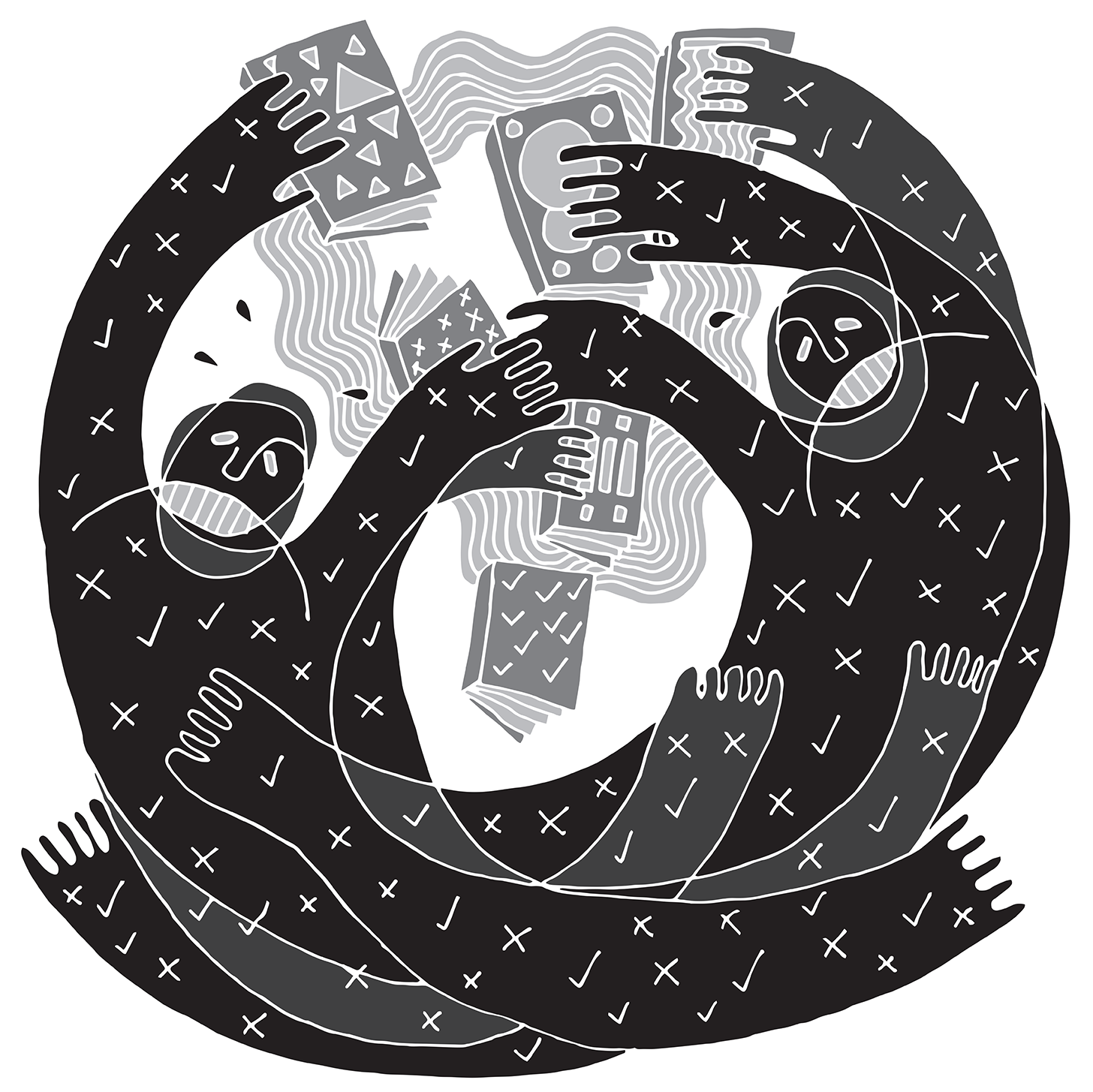
Founded in 1973 and with roughly 17,000 current members, the Park Slope Food Coop is one of the oldest and largest food coops in the United States. Unlike with many other food coops, buying your way out of working is not an option—everybody works. This means I walk for the privilege of fairly priced food. “Walk” because my job is to walk with people and their groceries to their homes, cars, the bus, or train, and then return to the coop with their pushcart. Put another way, I have strolling conversations with strangers for a few hours once a month.
I work the closing shift, 8:30-11:00pm. “Need a walker?” I ask as shoppers exit the bright musical bustle of the coop into Brooklyn’s well- lit night. There’s an agreed upon walking radius. Requesting an address beyond the boundaries constitutes a foul. If it’s early in the night I might say yes to going outside “the zone.” Closer to closing time, I’ll say no; otherwise my next day at work will be soured by exhaustion.
Recently a shopper came out and said, “I’m headed to Sunset Park,” which is over two miles away. I held my reaction for a beat and then we cracked grins together and had a laugh over the absurdity of walking that far. He revealed he was actually going to his car, parked only a few blocks from the coop. I was still chuckling to myself about the idea of walking to Sunset Park when I realized he had revved up into a lecture on the mechanics of persuasion—almost as though I had asked him about it. The hard shift in topic caught me off kilter in the way that speaking with a seasoned salesperson always does.
He had spent more than twenty years selling gold jewelry for the largest distributor of gold jewelry in the United States. He had perfected the subtle art of persuading mom and pop jewelers to buy into selling his dazzling wares. He talked about sizing up a jeweler by the anchor stores in their mall. Banana Republic called for one approach, Old Navy required something else. He’d walk in to warm welcomes and then watch the jeweler’s temperature drop as it became obvious that he was there to sell rather than buy. The jeweler would say “no thank you,” and then he’d say—and he paused here for emphasis—“no problem.” Turning toward the door, he'd mumble something about how his oldest customers had also initially said no to his program. According to him, a blend of his indifference and the word “program” typically piqued the jeweler’s interest. The merchant would ask a question, and he would then tug them into a back and forth designed to end in a sale.
We made it to his car and paused the conversation as I helped him lift a turkey into the trunk. After his groceries had been loaded and the pushcart stood empty he continued, “It’s about fear,” he said. “On both sides. You’re negotiating their fear, and your own. Buyers are scared they won’t get the value they’ve been promised. Sellers are scared their product’s value won’t be appreciated.” I nodded and he asked me what I did for a living; if I also worked in sales; if I could relate? I said I did work in sales—sort of—and simplified the story of my job—as I often do—by replying, “I’m a book designer.” I continued, “It’s my job to sell book cover and interior designs to editors, marketers, and authors, and ultimately those designs have to sell the book to readers.”
I can indeed relate. I’ve spent years refining my pitch. As a young designer I chased the dream of a one-and-done—when a cover design was approved without edits. But after achieving a few I noticed my one-and-done covers weren’t my best work. This was puzzling. Zero edits means perfection, right? In progressing from designer to director I realized just how many variables are at play in these decisions. Beyond the objective quality of a design—if such a thing exists—there is a rich stew of powerful stakeholders swirling around each project, and in the end the most powerful variable inevitably boils down to be time. All of my one-and-done covers had no doubt hit close to their deadlines.
Designers often talk about serving customer needs but our actual charge is more layered than that. In book publishing we serve readers, authors, editors, marketers, and more. There are many levels of need. The charge is to deliver not just a beautifully effective design, but also an approved design, and deliver it on time. Gaining approval starts with getting to know the people who will be doing the approving; it starts with understanding their fears so you can assuage them. Gaining approval requires guiding your approvers on a journey to their decision, guiding them through a story they can feel good about retelling.
“And how do you do that?” he asked, as an oversized dump truck roared past us. “I involve them every step of the way. I make them feel like they designed the book—even though I made all the design decisions.” I winked. He laughed. We shook hands, shared names, wished each other well, and parted ways. I wheeled the empty pushcart back towards the coop.
To hear me tell it, the design process was a pleasant-mannered affair, but he was right about the seller’s fear. Not just the garden variety fear that design will be undervalued when stood up against the efforts of other business functions. There’s also the fear that you won’t be able to get it done this time around. Not that you won’t be able to get it done creatively—your first decade of delivering on briefs will earn you a formidable creative shorthand and a justified confidence—no, I mean the fear that you won’t be able to persuade your approvers to say yes before the design is due.
When things do go awry, when stakeholders oppose one another, or fixate on being dissatisfied, the fallout is often an embarrassing display of blown deadlines and overspending. These occasional missteps flare out of securing approvals in the wrong order, or making an inconsiderate first impression. Sometimes conflict has been sown between your approvers before you even step into the room. Every design career is pockmarked with poorly orchestrated pitches and scars from approvers who proved unpersuadable.
In response, we set about constructing a foolproof process designed to keep everyone at ease, including ourselves. A list of past missteps codified into a prescription to cure the unexpected. First empathize, then define, ideate, prototype, and test—voila! But the prescription is largely a performance designed to mask the uncertainty of invention. Fool-proofing prevents missteps in a repetitive procedure, and yes every book is a rectangle, but the design process never truly repeats. Every design challenge calls for a unique approach in response to unique conditions. In publishing, unbeaten paths abound and we all stumble forward against the fear that we will fall.
The empty metal pushcart rattled over the broken ground. Park Slope is privileged with an abundance of trees whose roots cruelly crack up the cement and blue stone sidewalks. Pondering design missteps called to mind how frequently I used to trip during my first months walking the neighborhood. The light from inside the coop poured over the shoppers waiting out front for me to return. I scanned their faces looking for a cue from whoever was next in line. “Need a walker?”

